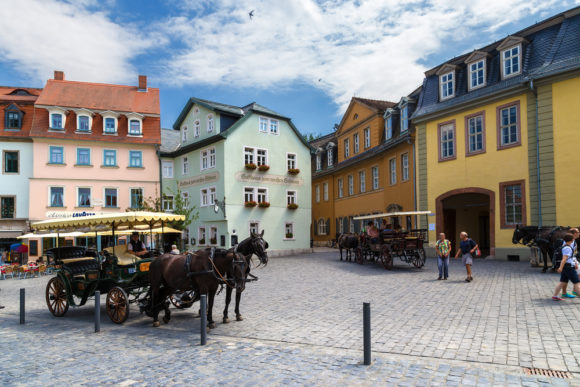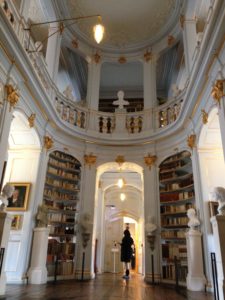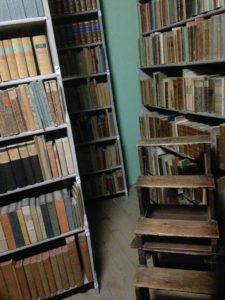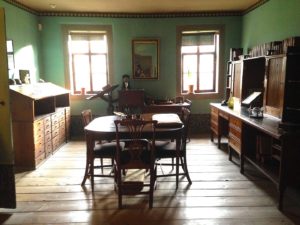Let Weimar’s rich cultural and literary history enchant you during a cozy weekend away in former East Germany. Colorful houses line the streets, the clicking of horseshoes dominate cobblestone squares and a blooming park embraces the entire city center.
Here’s the thing: I love historical figures. There’s just something about learning what inspired humans to become who they became that fascinates me. I also love museums, poetry and endless walks in parks, which may just be the reason Weimar is one of my favorite cities in the whole world. Good news: you do not need to be excessively interested in any of that to enjoy the spirit of this good old German small town.
So let me become your personal tour guide for this extraordinarily peaceful city, haunted by the sweet ghosts of artistic masterminds that shaped the era now known as ‘Weimarer Klassik’ (Weimar Classicism, 1772 – 1805). Whether you’re looking to find out more about Germany’s history or simply need a day away from the noise and stress of your daily life, Weimar is the place to go.
Fun fact: when asked to pose for this monument, Goethe said he will only do it if his friend Schiller can pose with him under the condition that they be portrayed the same size. (Schiller was much taller than him.)
The Impact of Anna Amalia
In 1758, Anna Amalia became duchess of Weimar and the town began its transformation to becoming the cultural capital of Germany. As one of the only female rulers of her time, she wanted the city’s education to focus on music and arts, which quickly drew in poets, painters and thinkers from all over the continent. To this day you can clearly see what her priorities were and it almost feels like a journey to simpler times.
The Anna Amalia library is simply beautiful. So even if you’re not interested in the literature itself, a wall of old books never fails to astound. Only a limited amount of visitors are allowed to go in per day so make sure to schedule it early in the day and buy your ticket in advance.
Goethe in Weimar
Germany’s favorite poet, author and playwright, Goethe, was born in Frankfurt in 1749 and died in Weimar in 1832. On a special invitation by Anna Amalia’s son, Carl August, Goethe came to town, moved to what is now known as his Gartenhaus (garden house) in the heart of the Park an der Ilm and soon fell in love with the city’s charm.
His beloved Ginko tree, which has inspired many poems, is still standing today. Despite many travels to Italy, he always returned to Weimar, where he eventually moved to what is now known as his Wohnhaus (living house).
He is buried next to his friend, fellow writer Schiller, whose house was located only a few yards from Goethe’s townhouse and serves as a museum as well, in the ‘Fürstengruft’, only a short walk from the city center.
Attractions
If you’re travelling with children, you can’t miss the multi-media show of the town’s history at the Weimarhaus. The tour takes you through a series of rooms, guiding you through time from the first settlers to Napoleon’s arrival at the castle all the way to a mini show of Goethe’s most famous work, Faust. Narration is available in English.
Discover the city from an entirely new perspective: via horse-drawn carriage. Depending on the length of your tour, it will take you to its most important sights and the majestical Park an der Ilm. While we remain glad that we don’t have to travel by coach these days, it’s a surprisingly soothing way to get around and gain a general idea of where everything is located. Many coach drivers are bilingual to answer any questions you might have.
No matter what your plans are or how long you’re in town for, you have to stop by the Goethehaus. It’s a magical combination of pompous furniture, bright accessories and anecdotes from the writer’s long life with just the right amount of books: innumerable. It serves as the home to the Goethe Nationalmuseum and houses many sculptures, paintings and belongings that he collected throughout his life. Every room is painted in a different color; its meanings are explained in an English audio guide. The beautiful garden can only be visited during the summer months but you can catch a glimpse through the windows facing it. Just make sure not to pose too closely to his personal carriage because the alarm will go off. Trust me on this one.
Other visitable houses include the afore mentioned Schillerhaus. It may look less spectacular at first due to the writer’s lack of fame in his lifetime, but still gives excellent insight into 18th century life.
The Bauhaus Museum is an architectural museum on Theaterplatz, established in 1995, which exhibits over 250 works by Bauhaus School teachers and students (1919-1933). Bauhaus style is famous for its modernist, independent designs.
Leonie Milde | Military in Germany
Restaurants
Speaking of warming our hearts; a nice cup of hot chocolate or coffee can not be missing during your tour, so make sure to stop by Café Gretchen (which dubs as a highly recommended family hotel) or Lily’s Waffel und Mehr on Frauenplan for homemade cakes and drinks.
If you’re looking for some good old German delicacies, you have come to the right spot. Three deliciously traditional restaurants line the city’s market square, Markplatz: Elephantenkeller (elephant basement, as you do), Zum Schwarzen Bär (‘Black Bear’, apparently naming restaurants after large animals was big at that time) and Restaurant Anna Amalia. All three are famous for their long history of extravagantly classical cuisine in an authentic decor.
Getting to Weimar
Located in the heart of Thüringen, Weimar is only a 3.5-hour drive from Kaiserslautern and Stuttgart and about an hour closer to Wiesbaden, so if you’re not looking to spend the night, you can absolutely turn it into a day-trip as well.
For public transportation options, check with Deutsche Bahn or Flixbus.
Getting around is easy thanks to public buses but most things are in walking distance of each other, so make sure to bring comfortable shoes and nothing can go wrong.
Author’s profile: Leonie is a poetry-loving literature student with a passion for small towns, road trips, and breakfast food that’s being served at all hours of the day. When she isn’t hopping from one bargain flight to the next, she is making sure you’re hanging with the locals and staying updated on events in your area.
Featured image by Valery Rokhin / shutterstock.com
Bookmark This Page Today for Exclusive Deals
Booking.com












